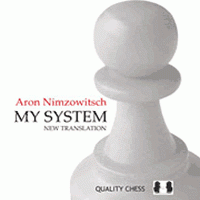We're learning chess strategy from the classic My System by Aaron Nimzowitsch. I'm your guide, likesforests. Grab a cold one, pull up a chair, and enjoy. :)
Review
We had a small break after lesson 2 "An Exchange Followed by a Gain of Tempo", so let's begin with a quick review. This is an example from chess.com play. White (1699) made the wrong choices and a couple moves later resigned a hopeless position. Will you do any better?
In the final position White has a clear strategic advantage. This is much better than game continuation, 3.fxe5?? Qh5+! 4.Ke2 Qxe4+ 5.Kf2 0-1. I hope you took ...Qh5+ into account in every variation you calculated. Always consider forcing moves.
§1.5 Liquidation followed by development
Before we discussed using exchanges to gain time. Now we'll look at some instructive examples where a well-timed exchange can avoid losing time. It's important to understand both sides of the coin... these two situations are closely related.
Example 1
The central pawns in this example are similar to those in the chess.com game we just looked at. White played the Scotch Game (1.e4 e5 2.Nf3 Nc6 3.d4) and Black replied 3...d5?!. Nimzowitsch notes that usually answering a pawn break with another pawn break is not ideal.
After a slight inaccuracy, Black's bishop maneuver saves him from losing time. Both sides have reasonable positions entering the middlegame.
Example 2
This example comes from the game of a fellow blogger, RTSolo. Black chooses the rare Baltic Defense to the Queen's Gambit (1.d4 d5 2.c4 Bf5?!), with interesting play.
Black has a powerful queen in the center which can't immediately be attacked, and he's almost ready to castle. But he's paid a price. Black needs to find counterplay before the White king castles, or the long-term advantage of the bishop pair may become decisive.
Example 3
Nimzowitsch describes liquidation as cutting your losses after a bad investment. It's better than losing time retreaing, but try to avoid such positions if at all possible. In the Philidor Defense (1.e4 e5 2.Nf3 d6 3.d4 exd4) how should White recapture?
While 4.Qxd4 is playable (4...Nc6 5.Bb5 Bd7 6.Bxc6), 4.Nxd4 is a better plan if White aims to win because it preserves the bishop pair and keeps as many pieces on-board as possible... which makes a favorable and decisive result more likely for the first player.
Nimzowitsch warns one should never make trades willy-nilly. Carefully consider whether to seek out, accept, or avoid trades. Intermediate players are sometimes too quick to say, "It loses the Bishop pair" or "It doubles her pawns" or "Don't trade a developed piece for an undeveloped one" without thinking deeply about whether the trade works in the position at hand. If you put some thought into your decisions, even if you're wrong, you'll learn and improve.
|
Further Reading:
The Art of Exchanging Pieces - In this Chess Mentor course, Jeremy Silman explores exchanging to create favorable minor piece imbalances.
|
I welcome criticism and even praise if you feel it's deserved. Lesson 4 will be out next Friday... if you haven't already, Add me as a Friend to enjoy it hot off the press!



